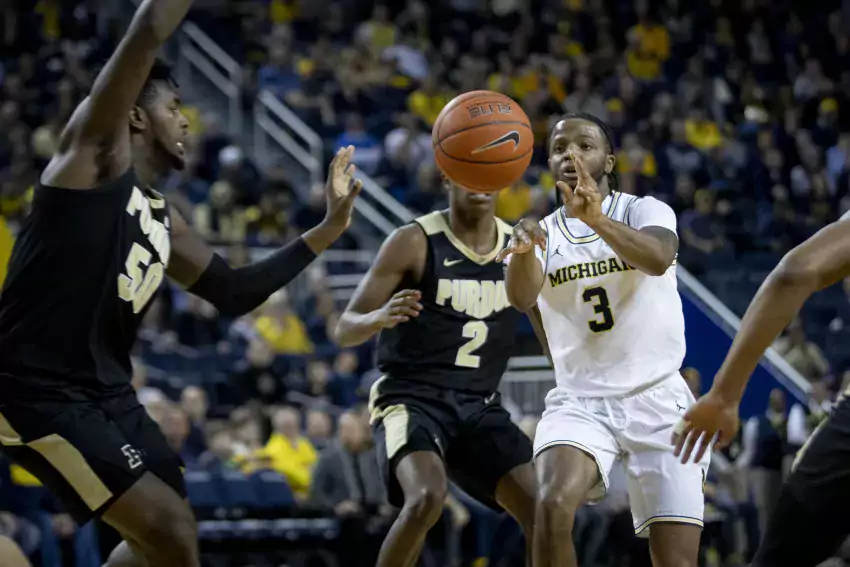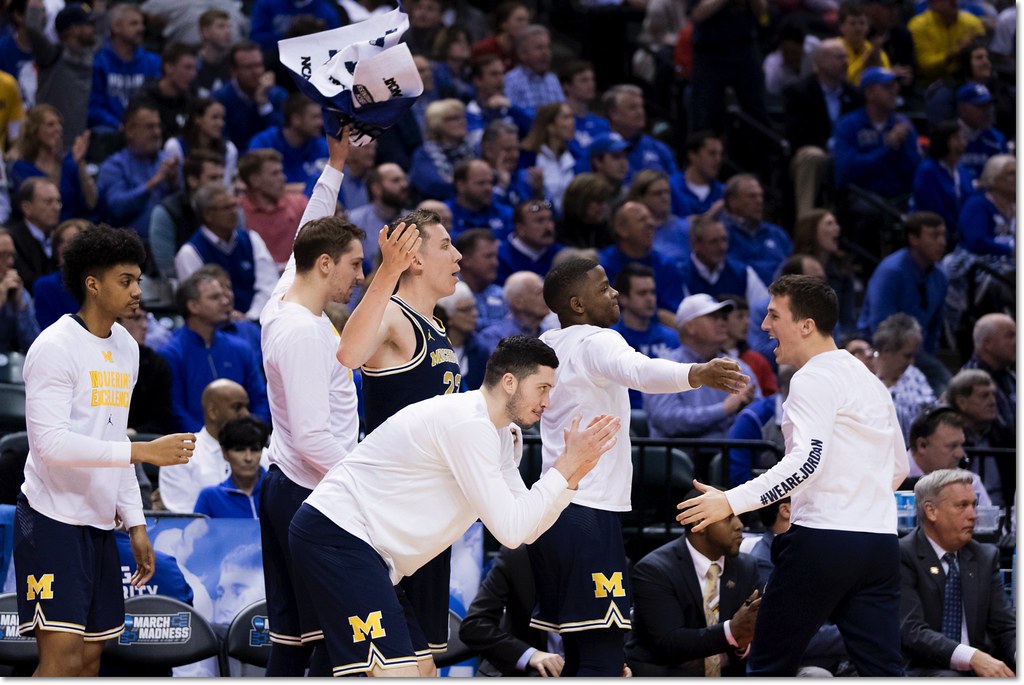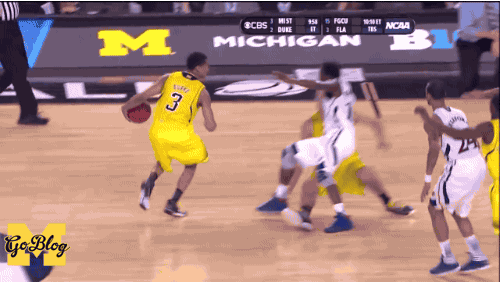max bielfeldt

Previously: Part One, Part Two. If you're looking for the Rutgers preview it's here.
You're definitely going to want to at least read part two of this series, which explains the stats I'm using below and details the 2009-14 seasons, before moving on to the rest of this post. Ideally, you'll read part one, as well.
Now that you're caught up, let's get to it.
2014-15: Bad Wheels
Team Stats: 27.7% pick-and-rolls + passes (#36 in country), 0.911 points per play (#62)
The Ballhandlers:
| P&R Plays (Own Offense) | PPP on Own Offense (%ile) | P&R Plays (Passes) | PPP on Passes (%ile) | Total P&R Plays | Overall P&R PPP. (%ile) | Keep % | |
|---|---|---|---|---|---|---|---|
| Spike Albrecht | 65 | 0.815 (70%) | 98 | 1.276 (92%) | 178 | 1.092 (93%) | 36.5% |
| Caris LeVert | 87 | 0.644 (35%) | 58 | 0.862 (34%) | 145 | 0.731 (28%) | 60.0% |
| Derrick Walton | 52 | 0.635 (33%) | 61 | 0.967 (54%) | 113 | 0.814 (47%) | 46.0% |
| Zak Irvin | 60 | 0.783 (63%) | 43 | 1.395 (96%) | 103 | 1.039 (90%) | 58.3% |
| MAAR | 39 | 0.872 (79%) | 19 | 1.737 (100%) | 58 | 1.155 (96%) | 67.2% |
The Screeners:
| Pop Plays (%) | Pop PPP (%ile) | Roll Plays | Roll PPP (%ile) | Slip Plays (%) | Slip PPP (%ile) | Overall Plays | Overall PPP (%ile) | |
|---|---|---|---|---|---|---|---|---|
| Max Bielfeldt | 12 (36.4%) | 1.167 (88%) | 19 (57.6%) | 1.000 (30%) | 2 (6.1%) | 2.000 (—) | 33 | 1.121 (76%) |
| Ricky Doyle | 1 (3.6%) | 2.000 (—) | 26 (92.9%) | 1.308 (74%) | 1 (3.6%) | 0.000 (—) | 28 | 1.286 (90%) |
| Zak Irvin | 9 (69.2%) | 1.222 (—) | — | — | 4 (30.8%) | 2.000 (—) | 13 | 1.462 (96%) |
| Mark Donnal | 1 (10%) | 3.000 (—) | 9 (90%) | 1.556 (—) | — | — | 10 | 1.700 (99%) |
I almost didn't include this season or the next because of Michigan's injury issues, then decided it was useful to see what happens when a team's two best perimeter players get hurt in the same season.
While neither Caris LeVert nor Derrick Walton were producing particularly well in the pick-and-roll before their respective foot injuries, we saw later that these injuries delayed breakouts into effective players—Walton, in particular, eventually became a great P&R ballhandler.
The players that remained were effective but one-dimensional. Spike Albrecht drove to pass. Zak Irvin and Muhammad-Ali Abdur-Rahkman hunted shots off of screens. Irvin, defying reputation, struck the best balance between shooting and passing, and he was a very effective passer. Only MAAR was above-average at generating his own offense off of screens, though.
Derrick Walton's foot injury stunted a developing rapport with Ricky Doyle
Michigan was also working with a limited group of finishers. Ricky Doyle was the best roll man but was a roll man only. Max Bielfedlt(!) ended up with the most plays among screeners even though he was a 30th-percentile finisher on the roll; he salvaged decent efficiency with some pick-and-pop jumpers. If Zak Irvin was setting a screen, it was to pop or slip for a jump shot.
This marks the first season since 2008-09 that Michigan's pick-and-roll usage went down; they also slipped 40 spots in the efficiency rankings. This team was going to drop off with the departures of Nik Stauskas, Glenn Robinson III, and Jordan Morgan, then injuries made matters worse. Even if LeVert and Walton weren't high-level P&R ballhandlers at this point, their spot-up shooting could've helped.
Even with all that, Michigan's pick-and-roll offense ranked in the 83rd percentile by points per play. They weren't elite; they were still good. They just couldn't build the offense around it to the extent they had the previous year.
2015-16: Bad Wheels 2
Team Stats: 30.5% pick-and-rolls + passes (#22 in country), 0.923 points per play (#80)
The Ballhandlers:
| P&R Plays (Own Offense) | PPP on Own Offense (%ile) | P&R Plays (Passes) | PPP on Passes (%ile) | Total P&R Plays | Overall P&R PPP. (%ile) | Keep % | |
|---|---|---|---|---|---|---|---|
| Derrick Walton | 128 | 0.711 (44%) | 120 | 1.000 (59%) | 248 | 0.851 (51%) | 51.6% |
| Zak Irvin | 149 | 0.826 (68%) | 98 | 1.306 (93%) | 247 | 1.016 (86%) | 60.3% |
| Caris LeVert | 57 | 0.877 (77%) | 62 | 0.855 (32%) | 119 | 0.866 (54%) | 47.9% |
| MAAR | 67 | 0.910 (82%) | 41 | 0.805 (24%) | 108 | 0.870 (55%) | 62.0% |
| Duncan Robinson | 19 | 0.632 (29%) | 17 | 0.647 (9%) | 36 | 0.639 (14%) | 52.8% |
The Screeners:
| Pop Plays (%) | Pop PPP (%ile) | Roll Plays | Roll PPP (%ile) | Slip Plays (%) | Slip PPP (%ile) | Overall Plays | Overall PPP (%ile) | |
|---|---|---|---|---|---|---|---|---|
| Mark Donnal | 12 (21.8%) | 0.500 (12%) | 40 (72.7%) | 1.250 (60%) | 3 (5.5%) | 0.667 (—) | 55 | 1.055 (60%) |
| Ricky Doyle | 1 (2.9%) | 2.000 (—) | 30 (88.2%) | 1.200 (54%) | 3 (8.8%) | 0.333 (—) | 34 | 1.147 (73%) |
| Moe Wagner | 3 (15.8%) | 1.667 (—) | 16 (84.2%) | 1.375 (77%) | — | — | 19 | 1.421 (95%) |
| DJ Wilson | 9 (64.3%) | 0.556 (—) | 4 (28.6%) | 1.500 (—) | 1 (7.1%) | 0.000 (—) | 14 | 0.786 (24%) |
| Zak Irvin | 9 (81.8%) | 1.000 (—) | — | — | 2 (18.2%) | 0.000 (—) | 11 | 0.818 (27%) |
An unfortunate repeat, as Walton's previous foot injury sapped his ability to finish at the rim and LeVert—who'd improved considerably as a scorer off the high screen—again lost most of the season to a bad wheel.
Beilein increased the volume past where it had been in 2013-14 and the team's PPP slightly increased, though they came out worse compared to the rest of the country. Irvin was easily the team's best P&R ballhandler, continuing to pass at a high level while making enough pull-up jumpers to be relatively effective as a scorer.
some of those jumpers were rather important
MAAR pulled off a tough feat, averaging more PPP using his own offense than when he passed; that's very much a good news/bad news situation.
The roll men remained limited. This was the year Ricky Doyle seemingly lost the ability to catch and finish, so Mark Donnal ended up as the primary screener. Neither graded out particularly well. The center who did: enigmatic freshman Moe Wagner, who scored well as a roll man and flashed the ability to pop out and hit jumpers.
[Hit THE JUMP for Michigan exploring that a bit more.]
 In fine form. [Marc-Gregor Campredon]
In fine form. [Marc-Gregor Campredon]
Previously: All-Bench
John Beilein has spent ten seasons in Ann Arbor. As of the most recent, he's the winningest coach in program history with 215. He snapped Michigan's post-sanction tournament drought in 2009, the first of seven NCAA appearances with the Wolverines, three of which have extended at least into the second weekend.
In recognition of the above, as well as the need for offseason #content, I've put together a series of All-Beilein teams, inspired by this twitter post and the ensuing conversation. My guidelines:
- I'm attempting to put together the best possible lineups, which isn't necessarily the same as picking the best individual players at each spot.
- I'm choosing individual player vintages (i.e. 2013 Trey Burke). A player can only be chosen once for each category, but different player years (i.e. freshman bench gunner 2014 Zak Irvin and well-rounded senior 2017 Zak Irvin) can be eligible for separate categories. The same player/year can be chosen for multiple categories—for instance, 2013 Mitch McGary making the All-Bench team doesn't exclude him from making the final All-Beilein team.
- Eligibility for certain categories may be slightly fudged because of the limited pool of players.
I'm not putting too many constraints on myself for this exercise since the point is to let our imaginations run wild. Speaking of running wild, this team is a little different than the others: today's group is comprised of the best contributors to the Bench Mob.
RINGLEADER: 2013-14 ANDREW DAKICH
The only member of the Bench Mob to merit his own highlight video. Dakich peaked in this role in 2013-14, when he could be the exuberant youngster instead of an assistant coach in the making. He's the ideal captain of a Bench Mob: he'll dance in the pregame huddle, be the first off the bench to greet players after a timeout, make a scene after a big shot, and coach up the point guards on the best way to approach the high ball screen. It won't be easy to fill (and leap out of) his seat.
Honorable Mention: 2012-13 Josh Bartelstein. Another walk-on who became a team leader, Bartelstein isn't your traditional hyper-excited bench fixture. Anyone with ESP, however, deserves serious consideration for the first team.

If we were ranking legendary Bench Mob moments, this would be at the top.
[Hit THE JUMP.]

Ricky Doyle played up to the competition. [Fuller]
While our attention has, for the most part, turned to football in the offseason, a new KenPom feature has me digging back into hoops. On individual player pages, KenPom now displays split stats for performaces against (1) conference opponents, (2) games against top-100 opponents, adjusted for game location, and (3) games against top-50 opponents, with the same home-court adjustment.
This is a very useful tool for parsing out how well players did against better competiton. Michigan's big man situation continues to fascinate me, so I thought it'd be useful to see how last year's troika performed against the best teams on the schedule, especially since the disparity in big man quality tends to be large between bad teams and good teams. While KenPom hasn't yet separated out stats for non-top-100 opponents (consider this a humble suggestion from a mathematically challenged blogger), we can get a baseline by looking at each player's full stat line from last season.
| %Min | %Poss | ORtg | OR% | DR% | TORate | Blk% | FC/40 | FTM-FTA | 2PM-2PA | 3PM-3PA | |
|---|---|---|---|---|---|---|---|---|---|---|---|
| Ricky Doyle | 43.7 | 17.9 | 117.4 | 10.4 | 11.9 | 12.0 | 2.6 | 4.0 | 39-66 (59%) | 72-119 (61%) | 0-0 |
| Max Bielfeldt | 34.2 | 22.3 | 107.2 | 12.4 | 19.5 | 13.7 | 1.9 | 3.8 | 22-32 (69%) | 54-99 (55%) | 8-30 (27%) |
| Mark Donnal | 22.3 | 17.0 | 119.6 | 10.2 | 16.1 | 9.6 | 3.8 | 6.4 | 19-27 (70%) | 25-44 (57%) | 7-19 (37%) |
And now, each player's stats against only top-50 opponents. This covers 13 games from last season; Ricky Doyle and Max Bielfeldt played in all 13, while Mark Donnal participated in 11 of them.
| %Min | %Poss | ORtg | OR% | DR% | TORate | Blk% | FC/40 | FTM-FTA | 2PM-2PA | 3PM-3PA | |
|---|---|---|---|---|---|---|---|---|---|---|---|
| Ricky Doyle | 51.4 | 15.5 | 117.7 | 8.3 | 13.5 | 12.6 | 2.2 | 3.8 | 16-25 (64%) | 33-55 (60%) | 0-0 |
| Max Bielfeldt | 32.7 | 22.9 | 91.8 | 8.7 | 21.9 | 16.7 | 2.1 | 4.6 | 8-11 (73%) | 19-38 (50%) | 3-14 (21%) |
| Mark Donnal | 17.0 | 20.6 | 128.2 | 13.9 | 7.3 | 3.6 | 4.0 | 8.4 | 7-11 (64%) | 12-22 (55%) | 2-6 (33%) |
The above helps clarify why John Beilein was comfortable letting Bielfeldt go despite having the opportunity to bring him back. A few takeaways:
Doyle held strong. Doyle's offensive numbers stayed almost exactly the same against top-50 competition; his shooting held at 60%, he took care of the ball, and he allowed the offense to run through the guards/wings. While his offensive rebounding dipped, he still did pretty well in that regard. Equally as encouraging was his ability to hold up defensively; Doyle's foul rate stayed level and he took on a larger share of rebounding duties against top teams.
Bielfeldt's shortcomings became apparent. Bielfeldt proved effective against mid- and lower-tier teams in large part because he dominated the offensive glass, providing himself with easy putback opportunties. Against top-tier teams, however, his offensive rebounding fell off dramatically, his turnover rate rose, and he didn't have a post game or reliable outside shot to make up for either.
Bielfeldt also resorted to fouling more on defense. He was clearly overmatched on that end against high-level competition and that took him out of games even when he had it going offensively; for example, he had nine points on 4-6 shooting in the home overtime loss to Wisconsin but picked up three fouls in 14 minutes because he couldn't defend Frank Kaminsky or Nigel Hayes.
Donnal showed promise on one end. Donnal's decreased role as the season wore on means his sample size is smaller than the others—he essentially played two games worth of minutes against top-50 teams, and he did so in short stints. Those short stints weren't always by design. Donnal was foul-prone in the best of times but especially against good teams; yes, that 8.4 fouls/40 minutes figure is real and speaks to some major defensive shortcomings that were apparent to anyone who watched him play.
There's hope in the offensive numbers, however. Donnal was... good? Again, the tiny sample size makes it hard to draw grand conclusions here, but his rebounding rate and shooting numbers are encouraging.
----------------
With a bulked-up DJ Wilson—listed at 6'9, 240 on the updated roster—set to bolster depth up front, it makes sense for Beilein to prioritize developing Donnal and Wilson into reliable options instead of giving significant minutes to a redshirt senior whose limitations become very apparent in the most important games. With a year of development under Ricky Doyle's belt and a logjam at the four, Michigan may only need one of those two to play a major role off the bench anyway.
2